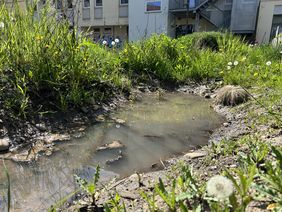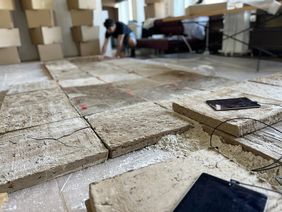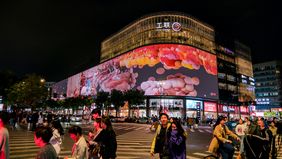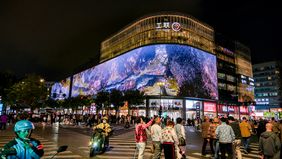


Bauhaus-Universität Weimar represented at Ars Electronica 2025 with projects from two faculties
The Bauhaus-Universität Weimar is participating in this year's Campus Exhibition at Ars Electronica 2025 in Linz with several contributions. In keeping with the festival motto »Panic«, students and faculty from the departments of Art and Design as well as Architecture and Urbanism are presenting artistic works that critically examine digital technologies, ecological contexts, and social issues.
As part of the Ars Electronica Campus Exhibition, the Media Art & Design programme of the Faculty of Art and Design is showcasing five artistic projects under the title of »Cybernetic Subjects«: The Pond, Ymr.x, Latent Heat Generation, She’s So Centsible, Sonic Ecologies, and Humans. The exhibition revisits cybernetics – the science of control, regulation and communication in systems – and critically examines the links to artificial intelligence (AI) and ecological practices. While cybernetic systems are modelled on nature, today’s technologies seldom aim to truly understand nature and the environment. This is precisely what the central project »The Pond« addresses.
For several semesters now, students and teaching staff have been using a combination of technical sensors (e.g. temperature sensors, microphones, cameras) and biological indicators to monitor a pond specially created on campus. Daphnia (water fleas) and Chlamydomonas algae count among the »natural sensors«. The research process can now be experienced in the multimedia installation forming part of the exhibition. The data received from the sensors is translated into sound or visual impulses, for example, to enable new sensory approaches to the environment. The reaction of the Daphnia to changes in water quality is also discernible. The project invites us to question the prevailing notions of AI, environmental control and technical measurability and to understand nature not merely as something for us to measure, but as a complex, living system.
Two projects from the master’s degree in MediaArchitecture offered by the Faculty of Architecture and Urbanism were selected for presentation at the »Beyond the Screens, City Digital Skin Art Festival«: digital works are being showcased that were originally created for monumental urban displays in Asia and Europe as part of a trilateral cooperation between the Bauhaus-Universität Weimar, the China Academy of Art, and Nanyang Technological University. Both explore with how urban media façades can be used as a storytelling tool to raise awareness of environmental issues among the general public. The master’s degree in »Digital Technologies in Architecture and Design«, which was recently renamed »MediaArchitecture«, acknowledges the growing importance of digital technologies in art, design and architecture and at the same time strengthens the interdisciplinary profile of degree programmes at the Bauhaus-Universität Weimar. Programme Director Professor Reinhard König emphasises: »Our participation in Ars Electronica shows how our students use digital technologies not only technically, but also in a socially reflective manner.«
In her work »Beyond the Funky«, Ayça Tugran creates surreal visual worlds that make us realise how much animal life is reduced to function and usability in the capitalist system. She contrasts the sentimental portrayal of domestic pets with the diversity of wild species and envisions a coexistence beyond control, categorisation and profit-driven thinking. In »Habitat«, Kevin Blackistone presents a floating terrarium as a metaphor for Earth’s fragile ecosystems and finite resources. He consciously juxtaposes these with fantasies of space colonisation.
About the festival
This year’s Ars Electronica is entitled »PANIC - yes/no« and is dedicated to the widespread uncertainty prompted by numerous crises, exploring how art can help to overcome this. Ars Electronica is one of the most important festivals for art, technology and society in the world. This year, it is taking place between 3 and 7 September 2025. The Campus Exhibition brings together contributions from over 30 international universities, opening up new perspectives at the interface between design, research and technology.
Ars Electronica Festival
3–7 September 2025, POSTCITY Linz
Festival website: ars.electronica.art/panic
Information on »Cybernetic Subjects«:https://ars.electronica.art/panic/de/view/cybernetic-subjects-21338ddb450c817ab718ce48a0a628f5
Information on »Beyond the Screens, City Digital Skin Art Festival«: https://ars.electronica.art/panic/de/view/beyond-the-screens-city-digital-skin-art-festival-cdsa-20038ddb450c8121b4e9e78f2f1bf4b7/
The exhibition »Cybernetic Subjects« was curated by Professor Ursula Damm (Professorship for Media Environments), Mindaugas Gapševičius (Artistic Associate, Professorship for Media Environments) and Junior Professor Kerstin Ergenzinger (Professorship for Acoustic Ecologies and Sound Studies). It brings together projects from research and teaching within the Media Art & Design programme: Jacob Elias Aran, Isabella Lee Arturo, Passion Asasu, Nina Bendix Igleses, Kerstin Ergenzinger, Negin Ehtesabian, Klaus Fritze, Mindaugas Gapševičius, Maximilian Götz, Diana Karle, Ting-Chun Liu, Mahla Mosah, Martin Müller, Parisa Salimi, Cosmo Schüppel, Jasper Seibert, Karlotta Sperling, Outi Wahlroos, Robin Max Wieber, Lisa Zwinscher
The projects by Ayça Tugran and Kevin Blackistone were created in the 2024 summer semester during the »Beyond the Screen« module of the master’s degree in MediaArchitecture under the direction of Professor Reinhard König (Professorship for Computer Science in Architecture and Urbanism), Susa Pop (Public Art Lab Berlin, Connecting Cities) and Carolina Garcia (MFA in Media Art & Design).
In case of questions, please contact Romy Weinhold, Press & Public Relations Officer of the Faculty of Art and Design, by telephone (+49 / 36 43 / 58 11 86) or via email (romy.weinhold[at]uni-weimar.de) or Gabriela Oroz, Communications Officer of the Faculty of Architecture and Urbanism, by telephone (+49 / 36 43 / 58 31 15) or via email (gabriela.oroz[at]uni-weimar.de).
Kontakt
Bauhaus-Universität Weimar
Claudia Weinreich
Pressesprecherin
Tel.: +49(0)3643/58 11 73
Luise Ziegler
Mitarbeiterin Medienarbeit
Tel.: +49(0)3643/58 11 80
Fax: +49(0)3643/58 11 72
E-Mail: presse[at]uni-weimar.de
Web: www.uni-weimar.de/medienservice

